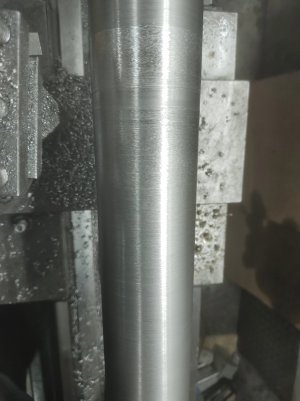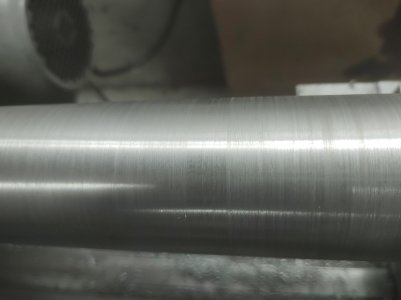Hello me and my buddy were playing around with the small lathe the other day and been trying to figure out were this problem is coming from. The machine is fairly worn so thinking some of the issue resides with that but curious of any ways to maybe correct the issue or mitigate it atleast.
Anyways the issue is as the carriage is traveling side to side in long cuts it seems to hit tiny bumps causing ever tiny low spots or high spots as the carriage travel threw the cuts.
Thought it maybe chips getting under carriage causing it but still happens if ways are covered. Also tightened the ways up as well. Except for the main carriage to the bed ways not sure how to adjust that one or if there is an adjust for it.
Using a cemented carbide cutter that we sharpened also tried it with new kennametal cemented carbide cutter more or less same results.
The rpm we tried was 320 and 240 for most runs and step over of .0025 up to .0080 something the lathe doesn't have a large step over rate range. And cut was less then .001 most of the runs more or less got similar results in different spots. Only a few .0001s if I a had to guess didn't measure didnt have test gauge with me.
The material is 2.375 shaft stock 4140? Maybe
Any insight on stuff we can try or maybe somewhere that isn't clean would be helpful. I would like to get better finishes then this if possible and get rid of the high low problem.
also the gear that feeds the carriage back and forth is very worn the gear teeth look like sharp vees more then gear teeth. Also think maybe part of problem.
Anyways the issue is as the carriage is traveling side to side in long cuts it seems to hit tiny bumps causing ever tiny low spots or high spots as the carriage travel threw the cuts.
Thought it maybe chips getting under carriage causing it but still happens if ways are covered. Also tightened the ways up as well. Except for the main carriage to the bed ways not sure how to adjust that one or if there is an adjust for it.
Using a cemented carbide cutter that we sharpened also tried it with new kennametal cemented carbide cutter more or less same results.
The rpm we tried was 320 and 240 for most runs and step over of .0025 up to .0080 something the lathe doesn't have a large step over rate range. And cut was less then .001 most of the runs more or less got similar results in different spots. Only a few .0001s if I a had to guess didn't measure didnt have test gauge with me.
The material is 2.375 shaft stock 4140? Maybe
Any insight on stuff we can try or maybe somewhere that isn't clean would be helpful. I would like to get better finishes then this if possible and get rid of the high low problem.
also the gear that feeds the carriage back and forth is very worn the gear teeth look like sharp vees more then gear teeth. Also think maybe part of problem.


